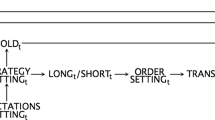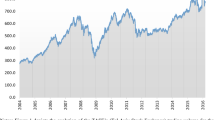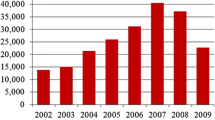Abstract
In this paper, we study the determinants of order aggressiveness and traders’ order submission strategy in an open limit order book market. Applying an order classification scheme, we model the most aggressive market orders, limit orders as well as cancellations on both sides of the market employing a six-dimensional autoregressive conditional intensity model. Using order book data from the Australian Stock Exchange, we find that market depth, the queued volume, the bid-ask spread, recent volatility, as well as recent changes in both the order flow and the price play an important role in explaining the determinants of order aggressiveness. Overall, our empirical results broadly confirm theoretical predictions on limit order book trading. However, we also find evidence for behavior that can be attributed to particular liquidity and volatility effects.

Similar content being viewed by others
Notes
For this reason, Pascual and Veredas (2004) consider the decision process as a sequential process with two steps. In the first step, the trader chooses between a market order, limit order and a cancellation, while in the second step, he decides the exact order placement.
For more details, see Sect. 4.3.
This model has been extended in several directions, see e.g. Bauwens and Giot (2000), Lunde (2000), Dufour and Engle (2000), Grammig and Maurer (2000), Zhang et al. (2001), Fernandes and Grammig (2001), Coppejans and Domowitz (2002) or Bauwens and Veredas (2004) among others. For an overview, see Hautsch (2004).
An interesting alternative would be the latent factor intensity (LFI) model proposed by Bauwens and Hautsch (2003), where the key idea is to allow for a common latent component which jointly drives the individual processes. Even though such a specification would be particularly interesting for the modelling of limit order book processes, its estimation requires substantial computational effort. As the computational burden for a six-dimensional process with included order book variables is already quite high, we leave the application of the LFI model in this context to future research.
In order to identify the constant ω k, s k(t) is set to one at the beginning of a trading day.
Clearly, modifying the order volume or the order price can affect the order priority. For more details, see Hall and Hautsch (2004).
Table 1 contains an exact definition of the variables.
However, motivated by the results by Hall and Hautsch (2004), we assume identical seasonality patterns on the ask and bid side.
Note that for each regressor six parameters have to be estimated.
The only exceptions are found for TLS. Here, some of the persistence parameters are even negative. These somewhat peculiar results might be explained by the fact that the dynamics in the order and cancellation processes for TLS are relatively weak and obviously interfere with the covariate processes.
This finding is consistent with the results of Hall and Hautsch (2004) who find similar results when analyzing the continuous buy–sell pressure at the ASX.
An exception is TLS. A shown by Table 5, even for a non-dynamic ACI model, the corresponding Ljung–Box statistics associated with the ACI residuals are already quite low indicating a reasonable goodness-of-fit.
In our setting, an updating of the information set occurs whenever a new point of the pooled process arrives. A further extension would be to account for any changes of the order book. However this would considerably increase the computational burden in our multivariate setting.
This result supports the idea of Bauwens and Hautsch (2003) to model the underlying market activity in terms of a latent autoregressive component which simultaneously affects all individual intensity processes.
References
Al-Suhaibani M, Kryzanowski L (2000) An exploratory analysis of the order book, and order flow and execution on the Saudi stock market. J Bank Financ 24:1323–1357
Bauwens L, Giot P (2000) The logarithmic ACD model: an application to the Bid/Ask Quote Process of two NYSE stocks. Ann Econ Stat 60:117–149
Bauwens L, Hautsch N (2003) Dynamic Latent Factor Models for Intensity Processes, Discussion Paper 2003/103, CORE, Université Catholique de Louvain
Bauwens L, Veredas D (2004) The stochastic conditional duration model: a latent factor model for the analysis of financial durations. J Econom 119:381–412
Biais B, Hillion P, Spatt C (1995) An empirical analysis of the limit order book and the order flow in the Paris bourse. J Financ 50:1655–1689
Bisière C, Kamionka T (2000) Timing of orders, orders aggressiveness and the order book at the Paris bourse. Ann Econ Stat 60:43–72
Bowsher CG (2002) Modelling Security Markets in Continuous Time: Intensity based, Multivariate Point Process Models, Discussion Paper 2002-W22, Nuffield College, Oxford
Brémaud P (1981) Point processes and queues, martingale dynamics. Springer, Berlin Heidelberg New York
Cao C, Hansch O, Wang X (2003) The Informational Content of an Open Limit Order Book, Discussion paper, Pennsylvania State University
Cohen KJ, Maier SF, Schwartz RA, Whitcomb DK (1981) Transaction costs, order placement strategy, and existence of the bid-ask spread. J Polit Econ 89(2):287–305
Coppejans M, Domowitz I (2002) An Empirical Analysis of Trades, Orders, and Cancellations in a Limit Order Market, Discussion paper, Duke University
Dufour A, Engle RF (2000) The ACD Model: Predictability of the Time between Consecutive Trades, Discussion paper, ISMA Centre, University of Reading
Engle RF, Russell JR (1998) Autoregressive conditional duration: a new model for irregularly spaced transaction data. Econometrica 66:1127–1162
Fernandes M, Grammig J (2001) A Family of Autoregressive Conditional Duration Models, Discussion Paper 2001/31, CORE, Université Catholique de Louvain
Foucault T (1999) Order flow composition and trading costs in a dynamic limit order market. J Financ Mark 2:99–134
Glosten LR (1994) Is the electronic open limit order book inevitable. J Financ 49:1127–1161
Grammig J, Maurer K-O (2000) Non-monotonic hazard functions and the autoregressive conditional duration model. Econometrics J 3:16–38
Griffiths MD, Smith BF, Turnbull DAS, White RW (2000) The costs and determinants of order aggressiveness. J Financ Econ 56:65–88
Hall AD, Hautsch N (2004) A continuous-time measurement of the buy-sell pressure in a limit order book market, Discussion Paper 04-07, Institute of Economics, University of Copenhagen
Handa P, Schwartz RA (1996) Limit order trading. J Financ 51:1835–1861
Handa P, Schwartz RA, Tiwari A (2003) Quote setting and price formation in an order driven market. J Financ Mark 6:461–489
Harris L (1998) Optimal dynamic order submission strategies in some stylized trading problems. Financ Mark Inst Instrum 7:1–75
Harris L, Hasbrouck J (1996) Market vs. limit orders: The SuperDOT evidence on order submission strategy. J Financ Quant Anal 31(2):213–231
Hautsch N (2004) Modelling irregularly spaced financial data—theory and practice of dynamic duration models, vol. 539 of Lecture Notes in Economics and Mathematical Systems. Springer, Berlin Heidelberg New York
Hollifield B, Miller RA, Sandås P, Slive J (2002) Liquidity supply and demand in limit order markets, Discussion paper, Centre for Economic Policy Research, London
Lo I, Sapp SG (2003) Order submission: the choice between limit and market orders, Discussion paper, University of Waikato, University of Western Ontario
Lunde A (2000) A generalized gamma autoregressive conditional duration model, Discussion paper, Aarlborg University
Parlour CA (1998) Price dynamics and limit order markets. Rev Financ Stud 11:789–816
Pascual R, Veredas D (2004) What Pieces of Limit Order Book Information are Informative? Discussion Paper 2004/33, CORE, Université Catholique de Louvain
Ranaldo A (2004) Order aggressiveness in limit order book markets. J Financ Mark 7:53–74
Russell JR (1999) Econometric modeling of multivariate irregularly-spaced high-frequency data, Discussion paper, University of Chicago
Seppi DJ (1997) Liquidity provision with limit orders and strategic specialist. Rev Financ Stud 1(1):103–150
Zhang MY, Russell JR, Tsay RS (2001) A nonlinear autoregressive conditional duration model with applications to financial transaction data. J Econom 104:179–207
Special thanks are due to James McCulloch whose assistance in preparing the data has made this research project feasible.
Author information
Authors and Affiliations
Corresponding author
Rights and permissions
About this article
Cite this article
Hall, A.D., Hautsch, N. Order aggressiveness and order book dynamics. Empirical Economics 30, 973–1005 (2006). https://doi.org/10.1007/s00181-005-0008-7
Published:
Issue Date:
DOI: https://doi.org/10.1007/s00181-005-0008-7
Keywords
- Open limit order book
- Aggressive market orders
- Aggressive limit orders and cancellations
- Multivariate intensity




